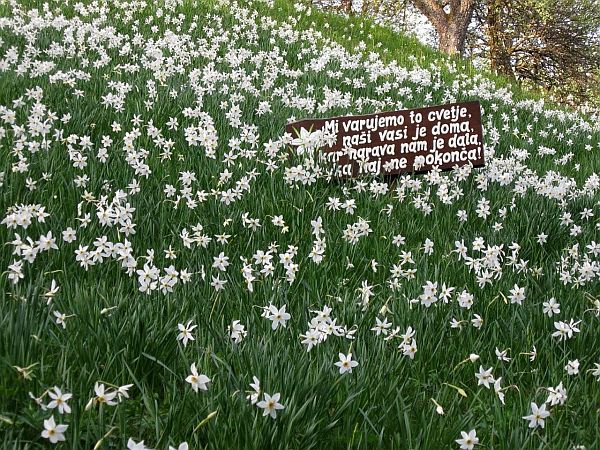
Each spring, something magical happens on the mountainsides above the industrial Slovenian town of Jesenice. Many of the normally lush green meadows on the slopes of Golica, a mountain on the border with Austria, turn almost completely snow-white. It’s not a late-spring snowstorm that is the cause of this magical transformation, but the blossoms of narcissi – wild-growing daffodils.
An annual festival organized in the mountainside village of Planina pod Golico marks the springtime arrival of the narcissi. Visitors from around the country and beyond flock to the area each May, during what is known as the Month of the Narcissi. In addition to marveling at the spectacular scenery, visitors have an opportunity to see several art exhibits, take part in organized hikes, watch traditional farm games, and enjoy a village fete. The event culminates when a young damsel is selected to become that year’s “Miss Narcissi.”
The local dialect even has a unique term for the flowers: “ključavnice,” which means “locks” in Slovenian. According to legend, God became angry when he saw that bees were collecting nectar on Sundays. Therefore, he installed locks on the narcissi flowers that prevented the bees from accessing the nectar on that day, and gave the flowers their name.
But the narcissus flowers responsible for the spectacular springtime display are more fragile than once thought. Over the decades, their number has been dramatically decreasing. While they still make many hills white, they have thinned out noticeably in some areas. On reason for this has been their very popularity: Despite signs urging visitors not to pick the flowers, too many of them cannot resist the temptation to take some of the home as souvenirs. A more significant reason for the loss of the loss of the narcissi has been overgrazing and the use of fertilizers. To limit the damage, authorities have instructed local farmers to set leave some of the pastures untouched and to use only natural fertilizers on their fields.
The picking of narcissi is forbidden by law. So far, the step has stopped the decline in the number of these magical flowers. The town of Jesenice is so confident in their future that the local tourist organization is betting on the snow-white narcissi fields to serve as the centerpiece of a campaign to make Jesenice and its surrounding mountains a prime tourist destination.

































































